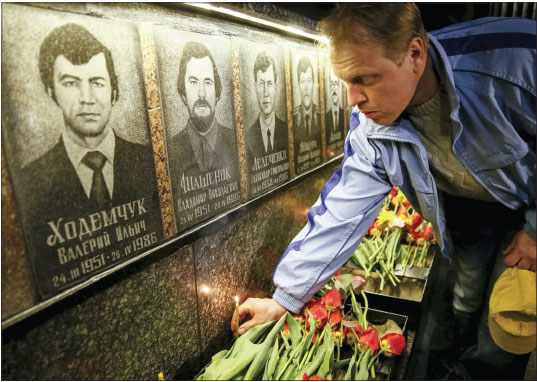30 years on, Chernobyl still calls
Some people found life away from home so unbearable they decided to return, even when home was the site of the world's worst nuclear disaster.
Maria Lozbin was one of tens of thousands of people to be evacuated from their homes after the Chernobyl accident in April 1986, but returned with her family six years ago, to live off the land inside a 30 km (19 mile) exclusion zone where the risk of radiation poisoning remains.
Ukraine prepared on Tuesday to mark the 30th anniversary of the Chernobyl nuclear disaster, caused by a safety test in the fourth reactor of the atomic plant that sent clouds of nuclear material across much of Europe.
The latest anniversary has garnered extra attention due to the imminent completion of a giant 1.5 billion euros ($1.7 billion) steel-clad arch that will enclose the stricken reactor site and prevent further leaks for the next 100 years.
The project was funded with donations from more than 40 governments. Ukrainian Prime Minister Volodymyr Groysman said lessons learned from Chernobyl should be heeded all over the world.
A 69-year-old with a ready laugh and a green shawl wrapped round her, Lobzin said the village to which she had been evacuated was full of drunks and drug addicts.
The house into which she was moved was so shoddily constructed, with a huge crack running from the roof to the basement, that she was afraid of being killed or maimed by a falling object.
"Living there was like waiting for death," she said.
Now she lives with her son and his family back in Chernobyl, in a zone that can only be reached by crossing a checkpoint and where guides accompany curious tourists with radiation meters.
By contrast, a deathly silence hangs over the nearby abandoned town of Prypyat, where a rusting fairground wheel, and a kindergarten with toys, dolls and small beds are a grim testimony to the scale and speed of the disaster.
Lozbin keeps chickens, geese and ducks, grows potatoes and tomatoes, and goes foraging for mushrooms in nearby woods.
"There is no radiation here. I'm not afraid of anything," she said. "And when it's time for me to die, it won't happen because of radiation."
The accident killed 31 right away and forced tens of thousands to flee.
World Health Organisation estimated the total cancer deaths from the disaster at 9,000.
A Greenpeace study also said people living in the area continue to eat and drink foods with dangerously high radiation levels.
In particular, "the 30 km exclusion zone around the Chernobyl reactor remains highly contaminated and unsuitable to live in," it said.
But that matters little to Lozbin, one of around 160 people estimated to have returned to the zone. "What's there to be afraid of?" said Maria's daughter-in-law Oleksandra Lozbin.
"I don't want to go to Kiev. Why would I leave such nature? Where could you hear cuckoos? Where could you hear the nightingale?"
Oleksandra's husband, who grew up in a village 7 km away, started coming to Chernobyl in short bursts starting in 2008 and the family settled back there permanently in 2010.
|
A man lights candles at a memorial, dedicated to firefighters and workers who died after the Chernobyl nuclear disaster, during a night service in the city of Slavutych, Ukraine on Monday. Gleb Garanich / Reuters |



















